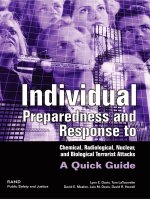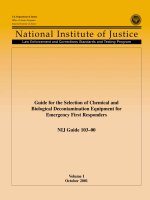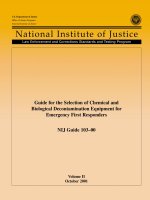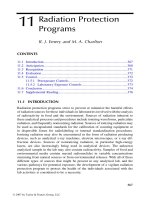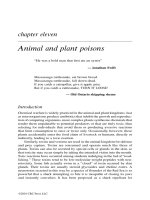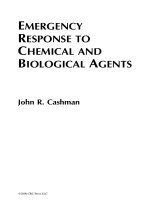EMERGENCY RESPONSE TO CHEMICAL AND BIOLOGICAL AGENTS - CHAPTER 11 ppsx
Bạn đang xem bản rút gọn của tài liệu. Xem và tải ngay bản đầy đủ của tài liệu tại đây (74.32 KB, 16 trang )
11
©2000 CRC Press LLC
Research Sources and
Resources
MANUALS USED BY HAZARDOUS MATERIALS
RESPONSE PERSONNEL
A manual, guidebook, or handbook may be used by first responders during the
initial stages of a hazardous materials incident. First responders or hazardous mate-
rials response teams (HMRTs) may obtain chemical information from computer
software, an emergency center, poison control centers, physicians, toxicologists,
chemists, or from Material Safety Data Sheets. However, chemical response manuals
such at the following are often carried on the response vehicle. Many HMRTs
require in their standard operating guidelines that at least three research sources
agree on the actions to take when responding to a specific chemical or agent.
Fire Protection Guide on Hazardous Materials
National Fire Protection Association, 1 Batterymarch Park, P.O. Box 9101, Quincy,
MA 02269-9101; 800-344-3555
Includes information on fire hazards properties (Section 325) and hazardous
chemical data (Section 49).
NFPA Hazardous Materials Response Handbook
National Fire Protection Association, 1 Batterymarch Park, P.O. Box 9101, Quincy,
MA 02269-9101; 800-344-3555
Contains text and commentary on the following NFPA /ANSI standards: 471
— Recommended Practice for Responding to Hazardous Materials Incidents, 472
— Standards for Professional Competence of Responders to Hazardous Materials
Incidents, and 473 — Competencies for EMS Personnel Responding to Hazardous
Materials Incidents. This handbook also includes sections on how to start a Haz
Mat team, the national response team’s Haz Mat emergency planning guide, the
Sacramento protocol for Haz Mat response, chemical compatibility of protective
clothing, and decontamination procedures.
North American Emergency Response Guidebook
Developed by U.S. Department of Transportation, Transport Canada, and the Sec-
retariat of Transport and Communications of Mexico. In the United States, response
personnel should be given the new edition free-of-charge, but it will also be available
from commercial suppliers. It contains information on shipping documents, identi-
fication and safety precautions, the hazard classification system, protective actions,
protective clothing, fire and spill control, and isolation/protective action distances.
It also contains 172 guides for different classes of chemicals that provide information
on potential hazards, public safety, and emergency response.
©2000 CRC Press LLC
Emergency Handling of Hazardous Materials in Surface
Transportation
Bureau of Explosives Publications, P.O. Box 1020, Sewickley, PA 15143;
412-741-1096; 412-741-0609 (Fax)
Designed for first responders, this manual was updated in 1998. It provides
commodity-specific descriptions and response information for all the U.S. Depart-
ment of Transportation-listed hazardous materials and for many specifically named
chemicals transported under a generic DOT description. Materials regulated only
by Canada and the International Maritime Organization (IMO) are also included.
Over 3600 individual regulated chemicals are covered. Features of this manual
include: basic properties of the listed chemicals; recommended methods of dealing
with the hazardous materials in the early stages of an emergency; a listing of
emergency environmental mitigation procedures; first aid information; suggested
chemical compatible protective equipment for some of the commodities.
Emergency Action Guides
Bureau of Explosives Publications, P.O. Box 1020, Sewickley, PA 15143;
412-741-1096; 412-741-0609 (Fax)
The purpose of the Hazardous Materials Emergency Action Guides is to provide
detailed information about the hazardous materials commodities most frequently
carried by rail transport. Each of the 134 guides provides 6 pages of basic data for
about 98% of the total volume of hazardous materials carried by rail.
NOISH Pocket Guide To Chemical Hazards (NIOSH Publication
No. 78-210)
U.S. Government Printing Office, Washington, D.C. 20402; 202-512-1803
This manual is a source of general industrial hygiene and medical surveillance
information for 397 individual chemicals or chemical types found in the work
environment.
CHRIS (Chemical Hazards Response Information System)
Developed by the U.S. Coast Guard and available through:
U.S. Government Printing Office, Washington, D.C. 20402; 202-512-1803
Although the CHRIS system is composed of four separate manuals, only Manual
2.2 — Hazardous Chemical Data — is of interest here. Manual 2.2 lists the specific
chemical, physical, and biological data for 1000 chemicals.
Quick Selection Guide to Chemical Protective Clothing
Kluwer Academic Publishing, 101 Philip Drive, Norwell, MA 02061; 781-871-6600
Managing Hazardous Materials Incidents (Volume I, Emergency
Medical Services),
Managing Hazardous Materials Incidents (Volume II, Hospital
Emergency Departments),
©2000 CRC Press LLC
Managing Hazardous Materials Incidents (Volume III, Medical
Management Guidelines for Acute Chemical
Exposure)
Information Center, Agency for Toxic Substances and Disease Registry, 1600 Clifton
Road, NE (E57) Atlanta, GA 30333; 888-422-8737 or 404-639-6360
Volume I includes information on emergency medical services response, with
sections on hazard recognition, principles of toxicology, personal protection and
safety principles, assessment, decon, treatment, transport, planning, and more. Vol-
ume II contains specific information for emergency department response to hazard-
ous materials incidents. Volume III is a guide for health care professionals and
outlines medical management for acute chemical exposures.
THE INTERNET
In the past, training and response information about nuclear/biological/chemical
(NBC) materials was strictly the purview of the military. For years, such information
was restricted as it contained technical or operational information for official gov-
ernment agency use only. The Tokyo subway incident, the bombing of the World
Trade Center in New York City, the destruction of the federal office building in
Oklahoma City, and other terrorist incidents within the United States caused the
government to change its methods of handling NBC information making it more
available to response personnel.
Hazardous materials response teams, trainers, and consultants should be aware
that previously “secret” NBC information dealing with use, epidemiology, sampling,
identification, defense, detection, protective equipment, decontamination, treatment,
and mass casualty management is now available from government agencies, indus-
try, commercial firms, and private interests on the Internet. Listed below are some
of the websites that provide military field manuals, information on chemical and
biological substances, and assistance to first responders and Haz Mat teams.
ACDA Homepage
/>
Home page of the Arms Control and Disarmament Agency. Provides information
on nuclear, biological, and chemical weapons and threats they pose.
American Chemical Society
The producer of the world’s largest and most comprehensive databases of chemical
information.
©2000 CRC Press LLC
American Conference of Governmental Industrial Hygienists
(ACGIH)
Publications, events, leadership, links, classified, etc.
American Industrial Hygiene Association (AIHA)
Frequently asked questions (FAQ) about industrial hygiene and AIHA, consumer
information, calendar, laboratory and scientific information, site index, etc.
American National Standards Institute (ANSI)
Provides national and international standards-related activities regarding ANSI,
standards information, conformity assessment, events, news, reference library,
searches, databases, etc.
American Society for Testing and Materials (ASTM)
/>
A voluntary group in which members devise consensus standards for materials
characterization and use, ASTM Standards, etc. ASTM provides a forum for pro-
ducers, users, ultimate consumers, and others to write standards for materials,
products, systems, and services. The society publishes standard test measures, spec-
ifications, practices, and guides. This site includes sub-sites for what’s new, national,
geographic, product, stage, FAQ, glossary, participation, and search.
Biological and Toxic Weapons Verification Program (Federation
of American Scientists)
/>
Briefing papers, negotiations, associated issues, project papers, biological weapons,
conventions, links, etc.
Canadian Centre for Occupational Health and Safety (CCOHS)
Products and services, Canadian Centre INFOweb, occupational safety and health
answers, education and training, about CCOSH, Internet directory, 100,000 Material
Safety Data Sheets, etc.
©2000 CRC Press LLC
Centers for Disease Control and Prevention (CDC)
About CDC, data and statistics, funding, health topics A-Z, in the news, other
sites/links, publications/software/products, training and education, travelers’ health,
etc.
Chemical and Biological Defense Information Analysis Center
/>
The CBIAC operated by Battelle Memorial Institute is a Department of Defense
(DOD) information analysis center. Established in 1986, the CBIAC serves as the
DOD focal point for information related to chemical warfare and chemical and
biological defense (CW/CBD) technology. The main interests of CBIAC are chem-
ical and physical properties of CW/CBD materials, chemical identification, combat
effectiveness, counter proliferation, counter terrorism, decontamination, domestic
preparedness, environmental fate and effects, force protection, medical effects and
treatment, toxicology, warning and identification, nuclear/biological/chemical sur-
vivability, demilitarization, manufacturing processes for NBC defense systems, etc.
The center collects, reviews, analyzes, synthesizes, and otherwise treats information
pertaining to chemical and biological warfare. Links to many other related sites.
Chemical and Biological Weapons Nonproliferation Project
(The Henry L. Stimson Center)
/>
This page is a clearinghouse for information on nonproliferation. It comprises a
home page, about us, what’s new, search, publications, projects, etc.
Counterproliferation/Chemical and Biological Defense
/>
Homepage of the Deputy Assistant to the Secretary of Defense for Counterprolif-
eration/Chemical and Biological Defense. Includes summary of activities, the Pen-
tagon’s Chemical and Biological Defense Program, and downloadable reports.
Chemical Manufacturers Association (CMA)
CMA home page, Responsible Care
®
, about CMA, what’s new, publications, com-
pliance center, workshops/seminars, news and information, issue advocacy,
CHEMTREC
®
, CHEMSTAR
®
, ChemEcology, and health research.
©2000 CRC Press LLC
Defense Advanced Research Projects Agency
/>
This home page of DARPA describes basic and applied research and development
projects being performed for the Defense Department. Provides a link to Biological
Warfare Defense Program.
Defense Special Weapons Agency
Provides information on the agency’s mission, director, programs, and the Defense
Nuclear Weapons School.
Dugway Proving Ground
/>
Homepage of the U.S. Dugway Proving Ground, location of many field tests of
chem/bio defense equipment. Also contains historical, chemical, and biological
warfare information.
Emergency Net News
/>
Provides emergency news from around the world.
Hanford Nuclear Site
/>
The U.S. Department of Energy’s plutonium production complex covering 560
square miles in Washington state is the world’s largest environmental cleanup project
(includes Hanford homepage page, site information, programs, opportunities, public
involvement, resource center, what’s new, etc.).
Harvard Sussex Program on CBW Armament
/>
Promotes the global elimination of chemical and biological weapons.
Health of Chemical-Biological Defense in the U.S. Military (A
White paper by the NBC Industry Group)
/>
©2000 CRC Press LLC
Idaho National Engineering and Environmental Laboratories
/>
About INEEL, engineering and science, environment, national programs, and oppor-
tunities.
The International Tanker Owners’ Pollution Federation (ITOPF)
The ITOPF homepage deals with information on response strategies, historical data
on oil spills, fate and effects of oil spills, planning for oil spills, compensation
schemes, cleanup techniques, and other factors.
Medical Radiological Defense
/>
Provides information on medical radiobiological research and education activities
of the Armed Forces Radiobiological Research Institute.
Medical Research and Materiel Command
http://140.139.42.108/home.html
Provides information on medical, chemical, and biological defense research pro-
grams and more.
National Emergency Management Association (NEMA)
NEMA is a professional association of state and pacific Caribbean insular state
emergency management directors seeking to provide leadership and expertise in
comprehensive emergency management, to serve as a vital information and assis-
tance resource for state and territorial directors and their governors, and to forge
strategic partnerships to advance continuous improvements in emergency manage-
ment. NEMA’s homepage has sub-sites for committees, conference, membership,
state contacts, file library, forum, and feedback.
National Fire Protection Association (NFPA)
Information on fire investigations, Oklahoma federal building bombing, hazardous
materials and chemical protective clothing standards, training materials and equip-
ment, etc.
©2000 CRC Press LLC
National Institutes of Health (NIH)
Contains a welcome message, news and events, health information, funding oppor-
tunities, scientific resources, links, publications, and information for employees.
National Institute for Occupational Safety and Health (NIOSH)
/>
Publications, databases, topic index, health hazard evaluations, training, state activ-
ities, extramural programs, what’s new, conferences, press releases, Federal Register
notices, highlights, about NIOSH, employment and fellowships, and links.
National Library of Medicine
The world’s largest medical library provides health information through MED-
LINE/MEDLINEplus, library services with catalog, databases, publications, train-
ing/grants, research programs, announcements, exhibits, hot topics, and general
information.
National Response Center
/>
The National Response Center is the sole federal point of contact for reporting oil
and chemical spills by telephoning 1-800-424-8802. On its homepage, you can view
NRC information, how to report a spill, legislative requirements, Chemical/Biolog-
ical Hotline, using NRC data, statistics, organization, links, monthly briefing, man-
agement, webmaster, and NRT/EPA/U.S. Coast Guard Internet homepages.
National Safety Council (NSC)
The NSC distributes CAMEO software and provides technical support for this
system which integrates a chemical database, emergency response information, an
air dispersion model and local maps with a data management capability. CAMEO
is the predominant chemical response software for firefighters and other first
responders.
Hazardous Materials Response and Assessment Division,
National Ocean Service, National Oceanic and
Atmospheric Administration
/>
This website can provide hazardous materials responders with valuable data and
information. NOAA scientists assigned to the Hazardous Materials Response and
©2000 CRC Press LLC
Assessment Division (NOAA HAZMAT) respond to dozens of oil spills and other
hazardous materials releases each year, help emergency planners prepare for poten-
tial accidents, and create software and other products to assist people in responding
to hazardous materials incidents. They provide two collections of materials of
interest to Haz Mat responders, Aids for Oil Spill Responders and Aids for Chemical
Accident Responders. Especially helpful is the Chemical Reactivity Worksheet— a
free program you can download and use to find out about the reactivity of chemicals.
It contains a database of over 4000 common hazardous chemicals and includes a
way for you to virtually “mix” chemicals to find out what dangers could arise from
accidental mixing. NOAA provides information on how to acquire any aids avail-
able.
North Carolina Emergency Management Division
State Emergency Response Commission, regional Haz Mat teams, etc.
Nuclear, Biological, Chemical Industry Group
/>
Homepage of the NBC Industry Group, an association of organizations supporting
NBC defense, domestic preparedness, and the Chemical Weapons Convention.
Organization for the Prohibition of Chemical Weapons
/>
Information, documents, the Chemical Weapons Convention, fact-finding files, links,
a complete report on nerve agents, etc.
Outbreak — Chemical and Biological Agents Internet
/>
Chemical and biological agents (dengue, Ebola, hantavirus, plague, smallpox, sta-
phylococcus, yellow fever, etc.), FAQ, active and historical outbreaks, resource
center, reading list, etc.
Program Manager for Chemical Demilitarization
/>
Provides information on the Chemical Stockpile Disposal Program, the Non-Stock-
pile Chemical Material Program, the Alternative Technology Program, the Chemical
Stockpile Emergency Preparedness Program, and the Cooperative Threat Reduction
Office.
©2000 CRC Press LLC
The PTS-OPCW-PrepCom Homepage
/>
The homepage for the Provisional Technical Secretariat, the Organization for the
Prohibition of Chemical Weapons Convention. Provides detailed information about
the treaty and more.
Safety Equipment Institute (SEI)
The SEI has adopted new testing procedures for chemical and biological terrorists-
incident protective clothing used by emergency responders. The new criteria include
meeting the requirements for inward leakage using a chemical surrogate that mimics
penetration of biological agents into protective ensembles. Ensembles must also
meet minimum protective levels against cyanogen chloride, lewisite, sarin, sulfur
mustard, and V-agent. This site features the following sub-sites: about SEI, board
of directors, certified products list, suppliers, standards and testing agencies, news
releases, SEI staff, and related links.
Agency for Toxic Substances and Disease Registry — Haz Mat
(ATSDR)
/>
“Medical Management Guideline for Acute Chemical Exposures” was developed
by ATSDR to aid emergency department physicians and other emergency healthcare
personnel to manage acute exposures resulting from chemical incidents, to decon-
taminate patients, to protect themselves and others from contamination, to commu-
nicate with other involved personnel, to transport patients to a medical facility, and
to provide competent medical evaluation and treatment to exposed persons. Selected
chemicals include benzene, formaldehyde, phosgene, ammonia, hydrogen peroxide,
hydrogen sulfide, xylene, arsine, methyl bromide, and others.
U.S. Army Chemical School
http:www.mcclellan.army.mil/
Homepage for Fort McClellan, AL. Provides information on the U.S. Army Chem-
ical School at Fort McClellan, one of the most advanced and sophisticated training
centers for chemical and biological defense.
The U.S. Army Medical Department and School
/>
Provides extensive information about the Army’s medical department. Includes
information on doctrine development and the use of medical products for victims
of weapons of mass destruction.
©2000 CRC Press LLC
U.S. Army Medical Research and Materiel Command
(USAMRMC)
/>
This website provides information on both chemical and biological defense products.
The chemical pages provide information on pretreatment, antidotes, and skin decon-
taminants of the following approved products: aerosolized atropine (MANAA),
convulsant antidote for nerve agent (CANA), nerve agent antidote kit (Mark I),
nerve agent pretreatment pyridostigmine (NAPP), and skin decontamination kit
(M291). Information includes countermeasures, status, availability, manufacturer,
point of contact, product description, effectiveness, dose and administration, side
effects, shipping/handling requirements, other available countermeasures, and con-
tingency protocol. The information can be printed or downloaded from this website.
The biological pages provide information on the following vaccines and bio-
logical substances: anthrax, plague, smallpox, and botulinum toxoid vaccine-pen-
tavalent. Information includes countermeasures, status, expected route of exposure,
availability, manufacturer, point of contact, product description, effectiveness, dose
and administration, side effects, shipping/handling requirements, other countermea-
sures, and contingency protocol. The information can be printed or downloaded.
U.S. Army Medical Research Institute of Chemical Defense
/>
Provides research information to advance the medical prevention and treatment of
chemical warfare casualties. It also offers medical chemical defense literature and
conducts the training program, “Medical Management of Chemical Casualties,”
which can be obtained from this site. This agency’s mission is to protect the
warfighter so that a sustainable force can be projected anywhere at anytime. The
Institute develops pretreatments and antidotes and provides instruction to protect
and treat casualties.
U.S. Army Medical Research Institute of Infectious Diseases
(USAMRIID)
This organization’s homepage is the location of much of the science and technology
research efforts for medical biological defense. The Institute, located at Fort Detrick
in the foothills of western Maryland’s Catoctin Mountains near the city of Frederick,
conducts research to develop strategies, products, information, procedures, and
training programs for medical defense against biological warfare threats. It is the
lead medical research laboratory for the U.S. biological defense research program.
©2000 CRC Press LLC
U.S. Army Soldier and Biological Chemical Command
(SBCCOM)
/>
Contains information about SBCCOM, command information, research and devel-
opment, strategy, press releases, publications, installation guides, products, pro-
grams and technology demonstrations, facilities, business and partnering opportu-
nities, assembled chemical weapons assessment, chemical stockpile program, DOD
combat feeding program, domestic preparedness, joint service materials group,
soldier enhancement program, community education, consumer research, hazardous
materials packaging and transport, environmental clean-up, modeling and simula-
tion, testing and analysis, chemical/biological helpline, chemical/biological hotline,
Materials Safety Data Sheets for chemical agents, etc.
U.S. Army Weapons Systems
/>
Provides links to information on nuclear, biological, and chemical detection.
U.S. Central Intelligence Agency (U.S. CIA)
/>
About the CIA, what’s new, publications, FAQ, speeches/testimony/press
releases/statements, document release center, related links, etc.
U.S. Department of Defense - Defense Link (U.S. DOD)
/>
The primary homepage of the Department of Defense (news articles, daily activities
summary, contracts, briefing slides, news archive, speeches, links to DOD organi-
zations, detailed search help, other news sources, news photos, etc.).
U.S. Department of Energy (U.S. DOE)
/>
News and information, people and pages, science education, content map, and
search activities.
U.S. Department of Energy (U.S. DOE)
Reports, testimony, current events, Yucca Mountain, websites, etc.
©2000 CRC Press LLC
U.S. Department of Energy (U.S. DOE) Technical Information
Service
A source for environment, safety, and health information (management tools, com-
ments, welcome tour, ES&H searches, DOE Tech Standard 1098-99 “Radiological
Control,” etc.).
U.S. Environmental Protection Agency (U.S. EPA)
/>
Searches, concerned citizens, researchers and scientists, small business/industry,
state/local/tribal, about EPA, projects and programs, other resources, news and
events, laws and regulations, databases and software, money matters, and publica-
tions.
U.S. Environmental Protection Agency (U.S. EPA) Chemical
Emergency Preparedness and Prevention
/>
EPA’s CEPPO provides leadership, advocacy, and assistance to prevent and prepare
for chemical emergencies, to respond to environmental crises, and to inform the
public about chemical hazards in their community. It deals with accident investiga-
tion histories, links to other websites, prevention, preparation, response, counter-
terrorism, laws and regulations, databases and software, search, emergency planning,
and Y2K.
U.S. Environmental Protection Agency (U.S. EPA) Emergency
Response Notification System
/>
Information maintained at the National Response Center on oil and hazardous
substance discharge and releases. Its sites include a table of contents, top ten spills,
spills in the news, ERN quick facts, search ENS, fact sheets, etc.
U.S. Environmental Protection Agency Hazardous Substances
Research Centers (HSRC)
The Hazardous Substance Research Centers conduct an active program of basic
and applied research, technology transfer, and training. Activities are conducted
regionally by five multi-university centers that focus on different aspects of hazard-
ous substance management. The HSRC homepage has sections for national, centers,
contact information, publications, research, and web links.
©2000 CRC Press LLC
U.S. Federal Bureau of Investigation (U.S. FBI)
/>
This Internet site for the FBI includes the top ten most wanted fugitives, crime
alerts, seeking information, kidnapping/missing persons, parental kidnappings,
unknown suspects, press room, major investigations, library, uniform crime reports,
programs and organizational initiatives, and a kids’ and youth education page.
U.S. Federal Emergency Management Agency (U.S. FEMA)
Mitigation, map service center, “know your risks,” nationwide urban search and
rescue (USAR) task forces, training, disaster recovery, etc.
U.S. Food and Drug Administration (U.S. FDA)
The goal of the FDA is to foster the national capabilities needed to respond to
potential chemical and biological threats from bioterrorism, including development
of new vaccines and drugs, safeguards for the food supply, and research for diag-
nostic tools and treatment of disease outbreaks. At the present time, the FDA is
requesting a total of $13.4 million for bioterrorism. The FDA site contains infor-
mation such as dockets, press releases, enforcement, reports, “FDA Consumer
Magazine,” FDA backgrounder, and the Center for Biological Evaluation and
Research.
U.S. Department of Health and Human Services (U.S. DHHS)
/>
There are 13 different agencies under the control of the U.S. Department of Health
and Human Services including the Agency for Toxic Substances and Disease Reg-
istry (ATSDR), the Centers for Disease Control and Prevention (CDC), the Food
and Drug Administration (FDA), and the National Institutes of Health (NIH) profiled
in this section. U.S. DHHS has the following sections on its homepage: about HHS,
healthfinder and human services information, news and public affairs, research/pol-
icy/administration, what’s new, search, gateways, and HHS agencies on the Internet.
U.S. Department of Justice (U.S. DOJ)
/>
The U.S. Department of Justice homepage contains the following items: what’s new,
organizations and information, press room, Freedom of Information Act, publica-
tions and documents, business with DOJ, community support and grants, fugitives
and missing persons, and justice for kids and youth.
©2000 CRC Press LLC
U.S. National Response Team (U.S. NRT)
Containing preparedness and response links, the National Response Center is the
sole federal point for reporting the release of oil or hazardous chemicals, including
chemical and biological agents, into U.S. waterways and environment.
U.S. Occupational Safety and Health Administration
(U.S. OSHA)
OSHA is an agency under the U.S. Department of Transportation with safety and
health regulatory and enforcement over most industry, business, and states within
the United States. OSHA’s homepage deals with programs, state plans, news
releases, speeches, testimony, publications, compliance links, Federal Register, stan-
dards, interpretations, directives, manuals, statistics, technical links, training, soft-
ware, and other subjects.
U.S. Department of Transportation (U.S. DOT)
/>
The U.S. DOT is responsible for the transportation of hazardous materials through
some of its 13 agencies such as the Federal Aviation Administration, the Federal
Highway Administration, the Federal Railroad Administration, the Maritime Admin-
istration, the Research and Special Programs Administration, and U.S. Coast Guard.
The U.S. DOT homepage deals with information about DOT, news and happenings,
dockets/rules/references, doing business with DOT, programs and initiatives, tech-
nology matters, Y2K, etc.
TELEPHONE HOTLINES
Chemical Emergency Preparedness Hotline: 1-800-535-0202
(CERCLA; SARA Title III)
Chemical Transportation Emergency Center: 1-800-424-9300
(CHEMTREC 24 hour, emergency only)
Domestic Preparedness CB Helpline: 1-800-368-6498
Emergency Planning & Community R.T.K. Act (EPCRA): 1-800-424-9346
Environmental Justice Hotline: 1-800-962-6215
Hazardous Waste Ombudsman: 1-800-262-7937
©2000 CRC Press LLC
National Institute of Occupational Safety & Health: 1-800-356-4674
(NIOSH Hotline)
National Pesticide Telecommunication Network: 1-800-858-7378
National Response Center CB Hotline: 1-800-424-8802
(24-hour hotline for use in reporting oil spills, chemical
spills, pipeline spills, transportation incidents,
and terrorist actions or releases)
Occupational Health and Safety Administration Hotline: 1-800-321-6742
(OSHA 24-hour hotline)
U.S. Department of Transportation Hotline: 1-202-366-4488
(Questions on regulation)
U.S. Environmental Protection Agency RCRA Hotline: 1-800-424-9346
(Superfund, Hazardous Waste)
U.S. Environmental Protection Agency Small Business
Hotline: 1-800-368-5888
Toxic Substances Control Act Assistance Information
Service: 1-202-554-1404
(TSCA)

